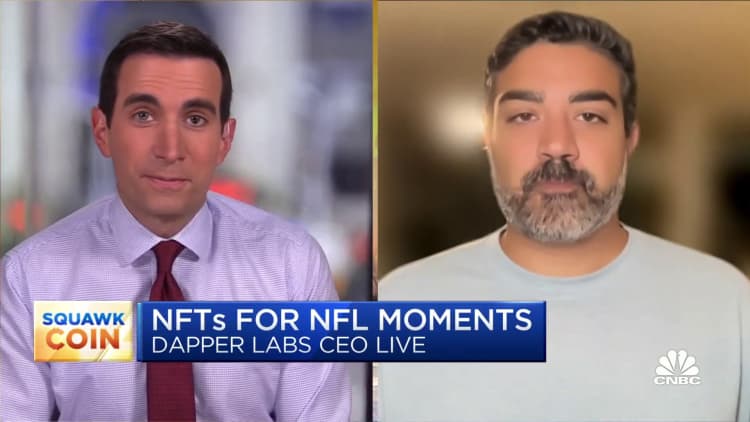Crypto startup MoonPay hires Time president to lead company
Keith Grossman, Time president
TIMEPieces Artist Jeremy Cowart
Time president Keith Grossman is leaving the legacy publisher to take on a new role as president of enterprise at crypto trading platform MoonPay, effective December 31.
Grossman joined Time in 2019, a year after Meredith Corporation sold the flagship magazine to Salesforce founder Marc Benioff and his wife Lynne for $190 million.
During his time at Time, Grossman has become a staunch champion of cryptocurrency and blockchain technology, pioneering the media company’s NFT business, TIMEPieces, generating more than $10 million in profits along the way.
“I’ve spent the last year operationalizing it,” Grossman told CNBC in an exclusive interview. “I think the transition will be scary in one way, because it’s something new and different, but at the same time stable in another way because we’ve consistently said that TIMEPieces was a community led by stewards, not founders.”
Prior to his three-plus years at Time, Grossman had held executive positions at major publishers including Bloomberg and Condé Nast-owned Wired.
Maya Draisin, Time’s chief brand officer, will lead TIMEPieces. Grossman began stepping down from the role of president in January to focus on the publisher’s NFT business when Ian Orefice was named president and CEO, according to a Time spokesperson.
Earlier this month, Time chief Edward Felsenthal announced he is stepping down from that role, although he will retain his editor-in-chief position and take on the additional role of executive chairman. Jessica Sibley, who was most recently CEO of Forbes, is now Time CEO.
Resists the FTX fallout
MoonPay’s pitch to investors is that it offers a “gateway” to digital assets. Currently, it includes bitcoin, ether and other digital tokens such as NFTs. But the collapse of FTX and its ongoing industry-wide ripple effects, combined with this year’s market volatility and risk-on investor environment, have not been kind to crypto trading.
“I think it’s important to separate a bad actor from an industry,” Grossman said of the FTX fallout. “If you look at the energy industry you had Enron; if you look at the healthcare industry you had Theranos; if you look at the financial industry you had Bear Stearns and Lehman Brothers, so it’s not surprising that the crypto industry will have its bad actors as well,” he said . “But some of the positives that will come out of it will probably be responsible regulation that will provide clarity for large companies that want to get into the space,” he said.
MoonPay co-founder and CEO Ivan Soto-Wright said his company has no meaningful exposure to FTX, although he added that this is a turning point for the industry with implications for all players.
Before filing for Chapter 11 bankruptcy protection amid allegations of misappropriation of customer funds, FTX offered trading on its exchange by storing digital assets in what are called custodial wallets, which enabled it to serve as an intermediary with customer funds. Soto-Wright says MoonPay’s platform is non-custodial and does not hold customer funds as part of its business model. But he added that comes with its own challenges.
“We’re starting to see some really big advances around MPC (multi-party computation) technology to make it safer,” Soto-Wright said. “But at the end of the day, if you’re a player in the space that’s going to hold client funds, you should fall under regulation.”
MPC technology has become essential in securing digital assets such as crypto because it ensures that no one person has access to a person’s data by splitting it into multiple parts.
Crypto’s crisis of confidence
In the 12 months since bitcoin peaked above $68,000, the crypto industry, once valued at roughly $3 trillion, has fallen to around $900 billion.
NFT sales have plunged into lockstep, falling every month since April, according to data from CryptoSlam. While the downturn has signaled to many that NFTs are a passing fad, Grossman is among a small group of evangelists who remain bullish on what has been dubbed “Web3” — a hypothetical future version of the Internet based on blockchain technology.
“It’s incredibly timely to have Keith on board,” said Soto-Wright. “Every single week you hear about another big brand announcing that they’re dipping their toes into Web3 and trying to implement a strategy.”
As MoonPay explored the reasons behind brand adoption of the concept and early use cases, “Keith’s name would come up a lot around what he was able to accomplish with TIMEPieces,” Soto-Wright said.
“He was able to provide a better experience for some of the most loyal customers and fans of the Time brand,” added Soto-Wright. “As we start talking to more and more big brands, they want to see how it actually works … while we have the infrastructure to make it happen, it’s still a strategy and I think Keith will unlock a lot of these the conversations as we enter the new year.”
Grossman will report directly to Soto-Wright.

Those who still buy NFTs do so in the belief that their ability to prove ownership of virtual objects, vis-à-vis the digital ledger that blockchain powers, will eventually increase in value as the use of decentralized technology grows .
Enterprise adoption has fueled this belief, with corporations included Nike, McDonald’s, Adidas and Starbucks launches its own NFT collections. Largely, these initiatives have been implemented through loyalty programs that are struggling to offset rising customer acquisition costs due to rising interest rates and record inflation.
In June, MoonPay partnered with Universal Pictures, Fox Corporation and Snoop Dogg’s Death Row Records, among other brands, to launch HyperMint – a platform that allows businesses and legacy brands like Universal, Fox or even Time to mint hundreds of millions of NFTs is. day.
MoonPay ranked #44 on this year’s CNBC Disruptor 50 list, and their services are used by more than 10 million customers in 160 countries.
Sign up for our weekly, original newsletter that goes beyond the annual Disruptor 50 list and offers a closer look at list-making companies and their innovative founders.



